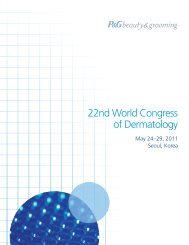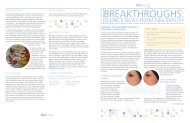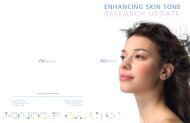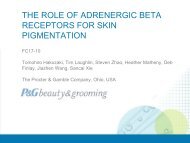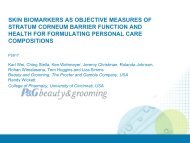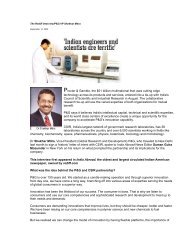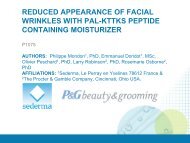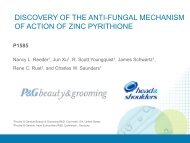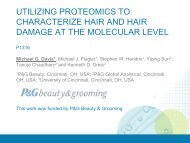improved facial surface sebum and pore appearance - P&G Beauty ...
improved facial surface sebum and pore appearance - P&G Beauty ...
improved facial surface sebum and pore appearance - P&G Beauty ...
Create successful ePaper yourself
Turn your PDF publications into a flip-book with our unique Google optimized e-Paper software.
IMPROVED FACIAL SURFACE SEBUM<br />
AND PORE APPEARANCE WITH<br />
NIACINAMIDE AND SDA<br />
FC02-06<br />
AUTHORS: Rosemarie Osborne, PhD, Rachel Rose-Mansfield, MS,<br />
Akira Matsubara, PhD, Cheri Swanson, PhD<br />
AFFILIATIONS: The Procter & Gamble Company, Cincinnati, Ohio<br />
USA <strong>and</strong> Kobe, Japan
Introduction<br />
• Niacinamide (Vitamin B3) is utilized in numerous topical cosmetic<br />
products to provide beneficial effects for a wide array of common skin<br />
problems such as those associated with aging <strong>and</strong> photoaging, e.g.,<br />
dryness, red blotchiness, hyperpigmentation, texture problems <strong>and</strong> fine<br />
lines/wrinkles (1-4). A general mechanism for niacinamide is as a<br />
precursor to the important cofactors nicotinamide adenine dinucleotide<br />
(NAD), its phosphate derivative (NADP), <strong>and</strong> their reduced forms<br />
(NADH <strong>and</strong> NADPH).<br />
• Dehydroacetic acid <strong>and</strong> its more water soluble salts such as Sodium<br />
Dehydroacetate (SDA) have been used as antimicrobial agents in a<br />
range of cosmetic formulations (5).<br />
• A screening program was conducted with a wide range of compounds<br />
<strong>and</strong> natural extracts to identify potential lipogenesis inhibitors. Two<br />
compounds identified were Niacinamide <strong>and</strong> SDA.<br />
• This report presents the in vitro responses as well as cosmetic benefits<br />
of Niacinamide <strong>and</strong> SDA-containing moisturizers for <strong>sebum</strong>-related<br />
endpoints.
Purpose/Objective<br />
• To evaluate effects of Niacinamide <strong>and</strong> SDA on<br />
lipogenesis in an in vitro model.<br />
• To determine potential cosmetic benefits of daily<br />
use of Niacinamide <strong>and</strong> SDA-containing <strong>facial</strong><br />
moisturizers for <strong>sebum</strong>, <strong>pore</strong>s <strong>and</strong> texture<br />
<strong>appearance</strong> endpoints in a clinical setting.
Methods<br />
• In Vitro Sebocyte Assay:<br />
– In vitro sebocytes have been used historically to evaluate effects of compounds on <strong>sebum</strong><br />
expression, including sebosuppression (6, 7). Lipid synthesis was detected via incorporation of<br />
radiolabeled glucose over a 3 hour period in the presence of test compound in cultured<br />
sebocytes (6, 7).<br />
• Clinical Studies:<br />
– Niacinamide Product Studies. Two 4-week studies were conducted with a niacinamide (2%)<br />
containing <strong>facial</strong> moisturizer in Caucasian (U.S) <strong>and</strong> Japanese female panelists. The cosmetic<br />
product was applied twice daily to the face <strong>and</strong> compared to the moisturizer base vehicle<br />
control in a double-blind, vehicle-controlled split-face r<strong>and</strong>omized (left-right) study design<br />
(Caucasian study), <strong>and</strong> as well as compared to baseline (both studies). Facial <strong>surface</strong> <strong>sebum</strong><br />
(Sebutape®) <strong>and</strong> <strong>pore</strong> <strong>appearance</strong> (image analysis) were determined at baseline <strong>and</strong> up to 4<br />
weeks. Self-assessments of improvements in <strong>facial</strong> skin <strong>appearance</strong> were obtained also.<br />
Comparison of treatment groups was accomplished by t-test analysis.<br />
– SDA Product Study. A double-blind study design similar to the that used for the niacinamide<br />
studies was used to evaluate a <strong>facial</strong> moisturizer containing 0.5% SDA in combination with<br />
3.5% niacinamide as compared to the moisturizer base vehicle control moisturizer. The<br />
panelists were Caucasian (U.S.) women in a 6-week vehicle-controlled split-face r<strong>and</strong>omized<br />
(left-right) study design, evaluating <strong>sebum</strong> (Sebumeter) <strong>and</strong> <strong>pore</strong> (image analysis) endpoints.<br />
Self-assessments of improvements in <strong>facial</strong> skin <strong>appearance</strong> were obtained also. Comparison<br />
of treatment groups was accomplished by t-test analysis.
In Vitro Results - Lipogenesis<br />
• Niacinamide reduced lipogenesis in a dose-dependent manner, with significant inhibitory<br />
activity observed up to 4.0% (w/v) niacinamide. For example, at 1% niacinamide (Fig. 1)<br />
lipogenesis was significantly reduced to 33% of control levels (p < 0.05, Student’s t).<br />
• SDA <strong>and</strong> its free acid form, dehydroacetic acid (DA), significantly (p < 0.05) inhibited<br />
lipogenesis by up to 82% over a dose range up to 0.15% in the in vitro lipogenesis assay.<br />
For example, at 0.1% (w/v), SDA <strong>and</strong> DA inhibited lipogenesis to 45% <strong>and</strong> 48% of control,<br />
respectively.<br />
Figure 1. In Vitro Sebum Lipogenesis<br />
100<br />
In Vitro Lipogenesis<br />
(% Control)<br />
80<br />
60<br />
40<br />
20<br />
0<br />
*<br />
*<br />
*<br />
1 % Ni ac 0.1%SDA 0.1%DA<br />
*p
Niacinamide Product – Surface Sebum & Pores (Caucasian Women)<br />
• Figure 2. Use of a moisturizer containing 2% niacinamide for 4 weeks<br />
led to decreased <strong>sebum</strong> (Sebutape®) <strong>and</strong> <strong>pore</strong>s (image analysis) in<br />
Caucasian women significantly vs baseline, <strong>and</strong> vs the vehicle control<br />
moisturizer.<br />
Sebum & Pore Reduction from Baseline (%)<br />
5<br />
-5<br />
- 15<br />
- 25<br />
- 35<br />
- 45<br />
* *<br />
*<br />
*<br />
2%Niacinamide<br />
Control<br />
Sebum Area Sebum Spots<br />
Pore Count Pore Area<br />
*p
Niacinamide Product – Surface Sebum & Pores (Japanese Women)<br />
• Figure 3. Decreased <strong>facial</strong> skin <strong>surface</strong> <strong>sebum</strong><br />
with use of a 2% niacinamide product for 2 or 4<br />
weeks in Japanese women. Images indicate<br />
Sebutape ® <strong>appearance</strong>. A majority (88%) of the<br />
panelists reported their skin was less oily.<br />
• Figure 4. Decreased <strong>facial</strong> <strong>pore</strong> <strong>appearance</strong><br />
with use of a 2% niacinamide product for 2 or 4<br />
weeks in Japanese women. Images indicate<br />
example <strong>facial</strong> images used for <strong>pore</strong> image<br />
analysis.<br />
Sebum Reduction from Baseline (%)<br />
0<br />
- 10<br />
- 20<br />
- 30<br />
- 40<br />
*<br />
*<br />
Week 2 Week 4<br />
*p
Niacinamide + SDA Product –Surface Sebum & Texture<br />
• Figure 5. Decreased <strong>facial</strong> skin <strong>surface</strong><br />
<strong>sebum</strong> (Sebumeter) with use of a 3.5%<br />
niacinamide product or a niacinamide + 0.5%<br />
SDA combination product for 6 weeks. A<br />
majority (62%) of panelists reported the SDA<br />
product reduced oily shine better than the<br />
niacinamide alone product.<br />
• Figure 6. Decreased bumpy <strong>facial</strong> texture/<strong>pore</strong><br />
<strong>appearance</strong> (% texture/<strong>pore</strong> area fraction) with<br />
use of a 3.5% niacinamide product or a<br />
niacinamide + 0.5% SDA combination product for<br />
6 weeks. A majority (70%) of panelists reported<br />
that the SDA product reduced texture & <strong>pore</strong>s<br />
better than the niacinamide alone product.<br />
Sebum Level<br />
(% Change from Baseline)<br />
0<br />
-5<br />
- 10<br />
- 15<br />
- 20<br />
- 25<br />
- 30<br />
- 35<br />
- 40<br />
- 45<br />
*<br />
Facial Texture/Pores<br />
(% Change from Baseline)<br />
0<br />
-2<br />
-4<br />
-6<br />
-8<br />
- 10<br />
- 12<br />
- 14<br />
- 16<br />
- 18<br />
* † - 20<br />
*<br />
* †<br />
Control Niac Niac+SDA<br />
*p
Figure 7. Improvement in Texture <strong>and</strong> Pores<br />
Baseline<br />
6 Weeks:<br />
Niacinamide + SDA Product
Conclusions<br />
• Niacinamide <strong>and</strong> SDA reduced lipogenesis in an in vitro sebocyte<br />
model (Fig. 1).<br />
• In both Caucasian (Fig. 2) <strong>and</strong> Japanese women (Figs. 3 & 4), use of a<br />
niacinamide-containing moisturizer reduced <strong>surface</strong> <strong>sebum</strong> levels as<br />
well as the <strong>appearance</strong> of <strong>facial</strong> <strong>pore</strong>s.<br />
• Use of a moisturizer containing a combination of niacinamide & SDA<br />
led to a significant reduction in <strong>surface</strong> <strong>sebum</strong> as compared to<br />
niacinamide product alone (Fig. 5).<br />
• The reduction in <strong>surface</strong> <strong>sebum</strong> was paralleled by reduction in uneven<br />
skin texture <strong>and</strong> <strong>pore</strong>s (Figs. 6 & 7). A majority of the panelists<br />
reported their skin was less oily <strong>and</strong> had reduced uneven texture <strong>and</strong><br />
<strong>pore</strong>s with the combination product.<br />
• These results indicate that <strong>facial</strong> moisturizers containing cosmetic<br />
ingredients such as niacinamide <strong>and</strong> SDA are valuable in reducing skin<br />
<strong>surface</strong> <strong>sebum</strong> as well as the <strong>appearance</strong> of uneven <strong>facial</strong> texture <strong>and</strong><br />
<strong>pore</strong>s.
References<br />
(1) Matts et al. 2002: A review of the range of effects of niacinamide in human skin.<br />
Intl Fed Soc Cosmet Chem Magazine 5:285-289<br />
(2) Bissett et al. 2003: Topical niacinamide provides skin aging <strong>appearance</strong> benefits<br />
while enhancing barrier function. J Clin Dermatol 32:S9-S18.<br />
(3) Soma et al. 2005: Moisturizing effects of topical nicotinamide on atopic dry skin.<br />
Int J Dermatol 44:197-202.<br />
(4) Draelos 2005: Niacinamide-containing <strong>facial</strong> moisturizer improves skin barrier<br />
<strong>and</strong> benefits subjects with rosacea. Cutis 76:135-141.<br />
(5) Final Report on the Safety Assessment of Sodium Dehydroacetate <strong>and</strong><br />
Dehydroacetic Acid (1985). J Am Coll Toxicol 4:123-159<br />
(6) Wheatley VR, Hodgins LT, Coon WM, (1970) Cutaneous lipogenesis. J Invest<br />
Dermatol 54: 288-297.<br />
(7) Seki T, Morohashi M 1993: Effect of some alkaloids, flavonoids <strong>and</strong><br />
triterpenoids, contents of Japanese-Chinese traditional herbal medicines, on the<br />
lipogenesis of sebaceous gl<strong>and</strong>s. Skin Pharmacol. 6:56-60.
This work was funded by P&G <strong>Beauty</strong> & Grooming



